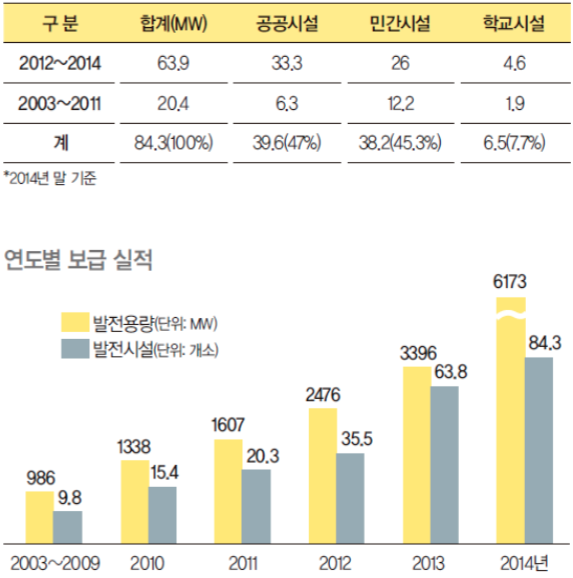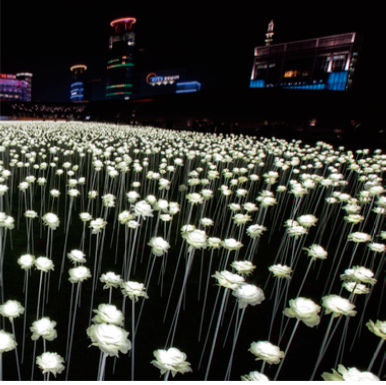New Renewable Energy: One Less Nuclear Power Plant
Energy Consumption and Production in Seoul
Energy Consumption Pattern
As of 2012, 94.6% of Seoul’s energy came from the following three energy sources: oil (37.7%), LNG (30.8%), and electricity (26.1%). Seoul’s reliance on LNG has remained around 30% since the 2000s while its electricity consumption increased from 21% in 2003 to 26% in 2012. During the same years, the proportion of renewable energy in the city’s energy mix jumped about three-fold.
By sector, industry makes up the largest portion of energy use in the nation while in Seoul the largest share (86.2%) is used by households and the commercial, and transport sectors together. The nationwide energy consumption by industry has been on the rise for the past 10 years while decreasing in Seoul.
Energy Production Pattern
In 2012, oil accounted for the largest portion of Seoul’s primary energy consumption, followed by LNG and renewable energy. The total consumption of primary energy peaked in 2007 and has since been declining slightly. Coal, in particular, has been showing a downward trend since its peak in 2006, while oil, too, is following. As of 2013, Seoul generated 1,946 GWh of electricity per year from its power production facilities located within the city, which are mainly thermal and renewable energy production plants. The production level, however, accounts for only 4.2% of its annual electricity consumption, which stands at 46,555 GWh.
Use of Renewable Energy
Since 2000, many more renewable energy facilities have been installed in Seoul. Facilities for photovoltaics, fuel cells and geothermal energy saw a particularly great expansion as well as those for heat generation from waste. Although facility expansion led to a 3-fold increase in production of renewable energy, as of 2012 green energy still accounted for only 26% of the nation’s total energy consumption and a mere 1.5% of the city’s. These figures suggest a clear need to expand the share of renewable energy.
Meanwhile, the share of photovoltaic (PV) generation dramatically soared from a mere 0.1% in 2003 to 2.5% in 2012. Yet, as of 2012, 92% of total renewable energy production came from bio-energy and energy from waste combined, making up the largest share of the mix. However, with Seoul’s One Less Nuclear Power Plant initiative, PV’s role is expected to be greater in the future.
Introduction of the One Less Nuclear Power Plant Project
Beginning
As of 2011, nuclear energy accounted for 31% (154,732 GWh) of the country’s annual power generation (496,893 GWh). Although nuclear energy is safe and efficient, it incurs enormous human, environmental and economic costs if something goes wrong, as was seen in the Fukushima nuclear disaster. Therefore, there has been an increasing demand for a safer, sustainable energy source.
Meanwhile, Seoul’s power consumption accounts for 10% of the national total, yet its power self-sufficiency rate is a meager 3.0%. In addition, Seoul’s power demand has been continually rising so that the increase is equivalent to the amount of energy generated by one nuclear power plant for an entire year.
To proactively respond to energy crises and climate change, the Seoul Metropolitan Government (SMG) worked closely with city residents to set up a comprehensive energy plan, one that would be the basis of the city’s attempt to reduce energy use and generate more energy from renewable sources. As part of this plan, the SMG introduced the One Less Nuclear Power Plant initiative, whose objectives included reducing the city’s energy demand by an amount equal to the capacity of one nuclear power plant (1 GW) by 2014. The longer-term objective is to reach 20% energy self-sufficiency by 2020.
Listening to Citizens & Experts
The SMG announced its One Less Nuclear Power Plant initiative on April 26, 2012 and laid out its ambitious goal of reducing energy consumption by 2 million TOE, equivalent to the production capacity of one nuclear power plant, by 2014. To materialize this initiative, the city government created a dedicated team and amended relevant ordinances.
Private sector investment was first attracted to establish the production bases for PV generation in Seoul. The SMG also amended institutions to encourage citizens to participate through small-scale generators. This was complemented by efforts to provide small-scale PV technology that can be utilized by multiple-unit dwellings.
At the same time, efforts were made to diversify the energy mix, adding fuel cells and small-scale hydro power plants as well as PV. The SMG also launched the Building Retrofit Project, or BRP, to improve building energy efficiency. To engage more of the population, long-term low-interest loans are provided. In fact, the interest rate was lowered from 2.5% to 2.0% in January 2013, and was further cut to 1.75% in December of that year.
Another important part of the One Less Nuclear Power Plant initiative is replacement of lights to LED. With private sector investment, the city government replaced 430,000 traditional lighting units in 243 subways stations in Seoul with eco-friendly LED lights. Lighting fixtures at other high energy-consuming places such as gyms and restaurants were also replaced with 4.97 million LED lamps.
Of all the programs and policies, the Eco Mileage program has proven the most effective. This voluntary, citizen participatory energy-saving program enjoyed the participation of 1.68 million people by June 2014, saving 190,000 TOE. In addition, Seoul runs a car sharing service known as Nanum Car. With two electric vehicle companies taking part now, the service could provide as many as 1,070 cars ready for sharing by 150,000 members who would give up driving their own vehicles by 2014. Other participatory programs include Energy Clinic, which has given eco-friendly driving instruction to 10,000 people, and the Energy Guardian Angel Corps.
.PNG)
Policy Outcome and Evaluation
Thanks to its multifaceted and multilayered approach, the city government successfully reached its target of reducing energy consumption by 2 million TOE during the 2 years between April 2012 and June 2014. As of 2013, Seoul’s energy consumption had dropped by 1.4% while the nation’s energy demand had increased by 1.7%. The One Less Nuclear Power Plant initiative is also meaningful in that it placed significant focus on renewable energy and energy efficiency as evidenced by its BRP project.
Furthermore, the initiative merits recognition as it engages citizens, seeks to change the perception of the public, creates jobs in the energy sector and helps the city strengthen its image on the world stage as a truly green city. In fact, in October 2012, Seoul became the headquarters of ICLEI and is slated to hold the ICLEI World Congress in 2015.
Phase 2 of the Project : Energy Housekeeping City
The SMG is launching Phase 2 of the initiative to bring greater value and vision to the capital city of Korea. For this, the more ambitious and far-reaching part of the project, the SMG has made every effort to listen to public opinion from the very beginning of policy design. It organized several discussion sessions to listen to the One Less Nuclear Power Plant Committee comprised of 48 people from academia, industry and the general public. It also listened through a variety of other channels such as the Seoul International Energy Advisory Council (SIEAC), social fiction, policy hearings and even online surveys.
The slogan of the second phase, “An Energy Housekeeping City” suggests that Seoul needs to clearly identify its role and present situation and use that information to create a city that is energy self-sufficient. The three core values include energy self-reliance, energy sharing and public participation.
20% Energy Self-Sufficiency by 2020
The main objective of the second phase is 20% energy self-reliance. To materialize this ambitious goal, the SMG will create a sustainable energy ecosystem, a virtuous cycle in which citizens produce energy themselves and consume it efficiently. To complement this, 88 unit projects under 4 policy categories will be implemented. With greater citizen participation in many of its projects and in the comprehensive 10 Key Actions Plan, the city believes that together, the city’s energy consumption can be cut and more energy produced from renewable, distributed sources. These changes, in turn, will boost Seoul’s energy self-sufficiency rate while reducing 10 million tons in GHG emissions and cutting energy consumption by 4 million TOE.
Decentralized Energy Generation
The SMG is committed to creating a city based on distributed energy, or decentralized energy in which everyone is involved in generating it cleanly and safely. In order to materialize its plans to have every citizen produce as well as use energy, the SMG intends to supply a variety of small, grid-connected devices such as PV systems (250W) that are easily installable on apartment balconies. These mini power generators will be provided to 8,000 households in Seoul this year, while a total of 40,000 households will be offered similar systems, resulting in each household saving about KRW 10,000 per month in electricity bills.
The SMG also plans to create a Civic Fund for PV Power Generation, which will allow citizens to directly invest and earn income from private power generation. The annual fund will provide a 4% return on investment and is expected to be KRW 10 billion in size by 2018. In addition, Seoul now requires new buildings to generate energy and heat, up to 20% of their energy consumption, from renewable sources and decentralized systems.
Efficiency & Low Energy Consumption
Towards energy efficiency and low consumption becoming norms in Seoul, the SMG will specifically target buildings, which account for 56% of the city’s total energy consumption. To this end, the city government offers consulting on individual building energy performance and loans (at 1.75% interest) for the cost of insulating or enhancing building energy efficiency.
For large new buildings, the current standard for environmental impact assessments will be strengthened. In addition, the use of energy-saving technology and facilities for all buildings will be enforced towards achieving “zero energy” by 2023. Seoul also plans to make information on building energy efficiency publicly available during sale/lease processes, so that the value of energy efficiency can be reflected in the building price.
As for lighting, all 2.2 million lighting fixtures in public buildings, street lights, and security lights in small alleys will be replaced with LED lamps while 65% of all privately-owned buildings, or 290 million lighting units, will also be replaced with LED.
Believing that saving energy is just as important as pursuing efficient energy use, Seoul is making every effort to engage the public. The best example of programs that seek participation is known as Eco Mileage, whose membership is expected to reach 2.8 million by 2018 through a variety of incentives.
Innovation & Jobs in Energy
The SMG plans to create quality, sustainable employment by promoting the energy industry and facilitating innovation. To this end, it will support the public sector first by fostering ICT electricity technologies, including smart grid and Building Energy Management Systems (BEMS) suitable for large cities. In addition, the city government will support the local energy service industry while facilitating start-ups, developing talent, and finding new market openings for those in the industry. The SMG plans to run pilot green cluster projects in 2015 in Gasan and G-Valley in Guri, two of the best-known clusters for renewable energy. The number of pilot clusters will expand to 6 by 2018 and include Mapo and Nowon.
Seoul will also foster social enterprises and cooperatives in green energy. An energy hub center will be built in each neighborhood to provide support with installation and monitoring, as well as post management, which in turn will provide more jobs.
Energy-Sharing Communities
Publicly-funded support will be extended to the energy poor, or those who suffer disproportionately from winter cold and summer heat. These people spend 4.7 times more on energy since they only have access to energy sources that are relatively expensive (LPG, kerosene) but low in efficiency. Unfortunately, there has been very limited support in this area. To change this, the SMG will take an inclusive approach to create better energy security for all.
Seoul will push institutional reform to ensure the protection of basic rights to energy. For instance, a welfare charter and relevant ordinances will be adopted and a welfare fund created to be run and distributed by citizens themselves. Currently, Seoul is targeting 100,000 participants for the fund, which will be funded by net profit from energy savings and generation (from PV, LED replacement, BRP), which will then be shared with the energy poor population.
Furthermore, to encourage continued and voluntary civic participation in energy generation, efficiency and reduction, Seoul will focus on expanding local energy communities such as the Energy Independent Community. The overall goal of the SMG’s energy policy is to create a virtuous cycle in which reducing energy use will become an entrenched part of everyday life and part of the culture.
New Renewable Energy System and Policy
Through the Seoul Energy Declaration in 2007, the goal of the nation’s first low carbon society vision and the obligation to reduce greenhouse gases were established. Furthermore, the 5 Year Green Growth Plan (2009-2013) was proposed, involving the application of low carbon technologies and the development of “green” cities. Along with this plan, demonstrative cities in the low carbon urban restoration project and low carbon, energy saving new city developments were selected and supported. Out of this, a specialized new renewable energy supply project was initiated for residential housing, buildings, and regions.
The SMG reflected regional properties and the flow of international society in establishing its Energy Master Plan in 2008. This Plan included a vision of ‘The realization of sustainable energy’ and, in the following year, the city strengthened its connection to the Energy Master Plan by announcing the 2030 Seoul Energy Master Plan, which included a vision of ‘Low carbon, green growth’. To realize this Plan, three initiation strategies were proposed: creation of a low energy consumption city, an energy recycling city, and an energy welfare city. To initiate these three strategies, specific plans were established to guarantee basic energy rights, encourage long and short-term energy saving, increase efficiency, and plan the supply of low carbon energy into homes, commercial buildings, transportation, and the public sector. In 2011, a goal was set to reduce GHG emissions and energy consumption, and increase the use of new renewable energy as part of the Seoul Energy Declaration. In addition, the 2030 Seoul Green Design Masterplan, which includes integrated and long term plans, was established to bring about compliance with the central government’s policy vision of low carbon green growth, and to propose an initiative to emphasize the properties of metropolitan Seoul.
The SMG came up with an integrated means of the One Less Nuclear Power Plant initiative through reduced energy consumption and increased generation of new renewable energy. The goal was established in 2012 to reduce energy use by 2 million TOE by producing 410,000 TOE through new renewable sources (including solar power and hydrogen cells), increasing energy efficiency in buildings and transportation, and reducing consumption by 1.59 million TOE.
In 2014, the initiative’s Phase 1 goal was achieved, and the Phase 1 project was effectively reinforced. The Phase 2 project was implemented, whose goals were to reduce energy consumption by 40 million TOE, achieve the energy self-reliance rate of 20% by 2020, and reduce greenhouse gas emissions by 10 million tons.
Table 1. Comparison of Phase 1 & 2 of Seoul’s One Less Nuclear Power Plant Initiative
| Phase 1 | Phase 2 | |
| Vision | ▪ Energy self-reliant construction | ▪ Seoul – An energy self-reliant city - Three energy values: independence, sharing, participation |
| Goal | ▪ Reduce energy consumption by 20 million TOE | ▪ 20% energy self-reliant (2020) - Reduce energy consumption by 40 million TOE, reduce GHGs by 10 million tons |
| Strategy | ▪ Production, efficient use of new renewable energy, and reducing overall energy consumption | ▪ Change social structure through institutionalization - Become a distributed energy generating city - Energy-efficient, low consumption social structure - Innovative jobs in energy - Create energy-sharing communities |
| Task | ▪ 71 projects in three fields | ▪ 88 projects with 23 tasks in 4 fields |
Source: One Less Nuclear Power Plant 2, Seoul Sustainable Energy Action Plan, Seoul
One Less Nuclear Power Plant Initiative
The SMG anticipated that the Phase 1 objective of reducing 2 million TOE would be completed in the first half of 2014, six months earlier than planned. It began discussing the establishment of a successive plan in January 2014.
Phase 2 included various professional meetings, citizen discussions, and analyses of overseas cases to realize the values of energy self-reliance, sharing, and participation. These were based on improved policies and innovation of the energy consumption structure achieved in Phase 1.
Discussions on how to implement Phase 2 were held by the One Less Nuclear Power Plant Plan Executive Committee, a private and governmental governance organization. The agenda was the values and visions of this phase. In order to establish an efficient executive plan, the existing four divisional committees were reformed into five divisions of General Affairs, Energy Generation, Energy Efficiency & Reduction, Energy Industry & Employment, and Energy Welfare & Community. After numerous meetings, they defined the tasks required to achieve the visions and values. Furthermore, a forum held to discuss policy for the energy industry and collect the broad opinions of experts and the general public.
Table 2. Phase 2 Executive Plan for the One Less Nuclear Power Plant Initiative
|
General Affairs Division |
Energy Generation Division |
Energy Efficiency & Reduction Division |
Industry & Employment Division |
Welfare & Community Division |
|
|
|
|
|
Source: One Less Nuclear Power Plant 2, Seoul Sustainable Energy Action Plan, Seoul
To better devise projects in Phase 2 of the One Less Nuclear Power Plant initiative, the opinions of citizens were actively collected through discussions and online forums. The name was selected as ‘Phase 2 of the One Less Nuclear Power Plant Initiative’ through a public naming competition in February 2014. In March, a survey of 2,000 citizens was done on awareness and willingness to participate in the One Less Nuclear Power Plant initiative. Furthermore, a Social Fiction Festival for Phase 2 of the initiative was held at Seoul City Hall with “10 Million Citizen’s Sunlight Imagination Fair for an Energy Self-reliant City of Seoul” as its theme. As many as 400 citizens attended to share their wisdom.
Phase 2 of the One Less Nuclear Power Plant initiative was planned to effectively reinforce the projects of Phase 1 and manifest the value of energy through a progressive change in production and consumption of energy and eco-friendly policy. Furthermore, efforts were made to supplement the associated problems, including lack of governance and lack of an integrated executive, which were identified in Phase 1. The One Less Nuclear Power Plant Executive Committee focused on application of new technologies, introduction of previously-implemented policies and exploration of new tasks.
Policy Goal
Figure 1. Three Values of Phase 2 of the One Less Nuclear Power Plant Initiative
| Energy Self-Reliance |
|
| Energy Sharing |
|
| Energy Participation |
|
Source: One Less Nuclear Power Plant 2, Seoul Sustainable Energy Action Plan, Seoul
The SMG has set expanding energy self-reliance as its goal, from 4.2% in 2013 to 20% by 2020. Development of new renewable energy and thermal convergence will be responsible for 46% of this self-reliance, while 54% is to be achieved through improved energy efficiency and reducing energy consumption.
Figure 2. Core Index: Prospects of Achieving 20% Energy Self-Reliance
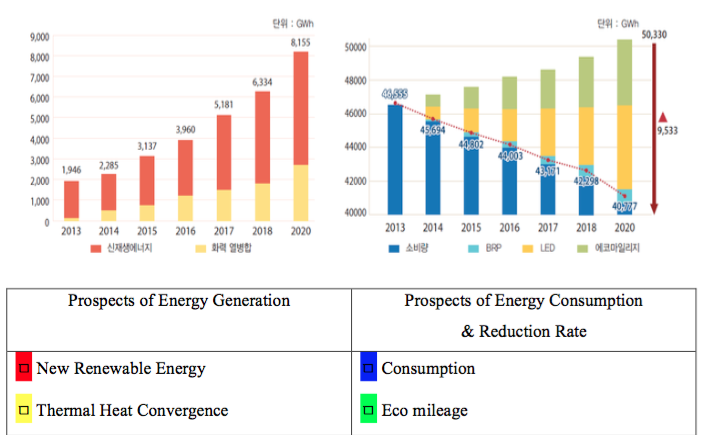
Source: One Less Nuclear Power Plant 2 Seoul Sustainable Energy Action Plan, Seoul City
The SMG has proposed reducing 10 million tons of greenhouse gases by 2020, a 20.5% reduction of the 49,008,000 tons CO₂eq emitted in 2011. To achieve this, 2,861,000 tons CO₂eq will be reduced through greater energy efficiency, 2,148,000 tons CO₂eq through the use of new renewable energy, 2,119,000 tons CO₂eq through lower consumption, 2,094,000 tons CO₂eq through the expanded use of LEDs, 576,000 tons CO₂eq in the transport area, and 245,000 tons CO₂eq through generation of thermal energy. The final goal is to reduce by 10 million tons CO₂eq.
Figure 3. Reduction of 1 Million Tons of Greenhouse Gases
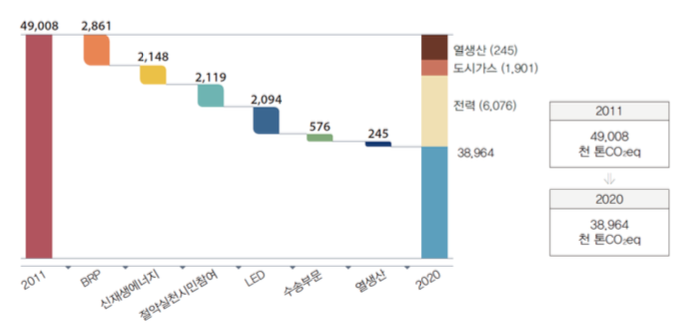
Source: One Less Nuclear Power Plant 2 Seoul Sustainable Energy Action Plan, Seoul City
Necessity of Plan
Seoul’s energy self-reliance rate is remarkably lower than its energy consumption, and the generation of new renewable energy represents a mere 1.5%. There is a need for a new energy policy paradigm.
Although nuclear power is a cheap and efficient source of energy, it comes with significant human and financial costs should a problem occur, as demonstrated by the Fukushima nuclear accident in Japan. Seoul is reducing its need for nuclear power plants through the generation of environmentally-friendly energy. As much as 90% of greenhouse gases, which increase the earth’s temperature, are caused by the generation and consumption of energy; thus, the SMG has endeavored to do its part to decrease these rising temperatures and make the city healthy and safe for future generations.
Due to climate change and the possible depletion of fossil fuels, new renewable energy is seen as the future’s sustainable energy resources. However, the new renewable energy sources that have been developed so far are not sufficient or come at a high cost. There is a need, therefore, for more research and development and better policies for new renewable energy, and the SMG is working hard in this area.
Figure 4. The Need for the One Less Nuclear Power Plant Initiative

| Low energy supply rate (3.0%) Rapid increase in power consumption |
Need for energy self-reliance in preparation for energy crises | Reduction of energy consumption by 2 million TOE through the reduction of energy use and expanded generation |
| Increased public anxiety after the Fukushima nuclear accident | Need for safe, sustainable energy sources | |
| Intensified global warming and signs of climate change | Need to reduce greenhouse gases |
Main Policy Contents
Figure 5. 4 Guidelines in the One Less Nuclear Power Plant Initiative, Phase 2
| 4 Energy Policy Guidelines | |||
| Expansion of Distributed Generation 5 Tasks, 19 Projects |
Energy Efficient City 9 Tasks, 34 Projects |
Good Energy Worksites 4 Tasks, 17 Projects |
Realization of Welfare through Sharing 5 Tasks, 18 Projects |
| 1. Seoul – A City of Sunlight! Project 2. Opening of the distributed energy generation era in buildings 3. Expansion of group energy to 60,000 units by reducing heating costs by 20% 4. Finding unused energy within the city 5. Active support for energy self-reliance through innovative policies |
1. Proclamation of the “Zero Energy” initiative for new buildings 2. Healthy and comfortable architectural city through diagnosis of energy situation and increased energy efficiency 3. Strengthened responsibility for increasing energy efficiency in the public sector 4. Seoul – A city of LED lights! 5. Transformation of urban structure to low energy consumption 6. Expand supply of “green” vehicles 7. Creation of an energy conserving traffic environment 8. Creation of an energy-efficient daily culture 9. Creation of the world’s top recycling city |
1. Creating green energy work places with the public 2. Customized support for each phase of green energy corporation lifecycles 3. Construction of the green energy industry and green technology infrastructure 4. Fostering IT-based green energy innovation and technology |
1. Construction of an energy welfare fund (platform) with public participation 2. Guarantee basic energy rights 3. Conversion and increased efficiency of reducing energy costs 4. Special means for the energy minority class 5. Energy community projects |
A distributed energy generating city
Next is a focus on the 4 projects of public participation, distributed power, generation of new renewable energy, and regionally-specialized energy. The initial goal is to increase dispersed power sources of small sizes through new renewable energy and thermal convergence generation.Figure 6. Initial Goals of Energy Dispersed Generation City
| Public Participation | Dispersed Power | Generation of New Renewable Energy | Regionally-Specialized Energy |
| 40,000 mini solar power units | 61 MW self-thermal convergence | 300 MW from solar and fuel cell power | 1.65 million Gcal cooling and heating energy |
Source: One Less Nuclear Power Plant 2, Seoul Sustainable Energy Action Plan, Seoul
More support is offered to expand the supply of new renewable energy led by the public sector to include small-scale generation of private buildings as well as the initiation of policies in which the public participates, including mini solar power units, sunlight generation citizen funds, and mini power plants.
Along with the mandatory implementation of distributed power, policies are also in place to increase power generation within the city. As it works to achieve this, the SMG will introduce stricter criteria for environmental impact assessments, and lower the cost of city gas for fuel cells and thermal convergence generation.
1) Production of ‘healthy, clean electricity’ with Citizen Sunlight Generation
- To change people from energy consumers to energy generators, interest in environmentally-friendly energy is induced by supplying 40,000 250W mini solar power units, which are easy to install on apartment balconies and house verandas.
- 10MW solar power units will be installed on urban streets by 2018 to directly fund a Sunlight Generation Citizen Fund, from which the public will enjoy any profits.
- The installation of solar light is continually expanded using unused spaces (such as school roofs and the outside of corporate buildings), and the locations for the installation of solar power generation facilities using public sites are then diversified.
- The improvement of policies for expanded installation of solar power generation units is continually carried out while the reintroduction of feed-in tariffs is proposed to the central government to protect the profits of small-scale generators.
|
Figure 7. Solar Power Generation Facility Building 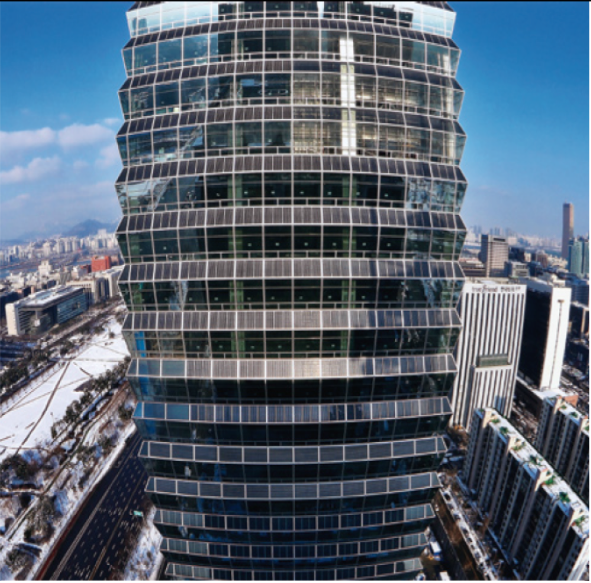 (Source: Seoul Remarkable Environment Policy (Energy City Seoul) One Less Nuclear Power Plant Plan, Seoul City) |
Figure 8. Current Status of Solar Power Generation Facilities
(Source: Seoul Remarkable Environment Policy (Energy City Seoul) One Less Nuclear Power Plant Plan, Seoul City) |
2) A safe city with distributed electricity generation
- As of 2013, there were forty-six 89 MW self-thermal convergence generating apartment and other buildings in Seoul. These units generate electricity and heat in large buildings and are to be expanded from 90 MW in 2014 to 150 MW by the end of 2018.
Figure 9. Rooftop Solar Panel on Top of Gangseo Agricultural Market
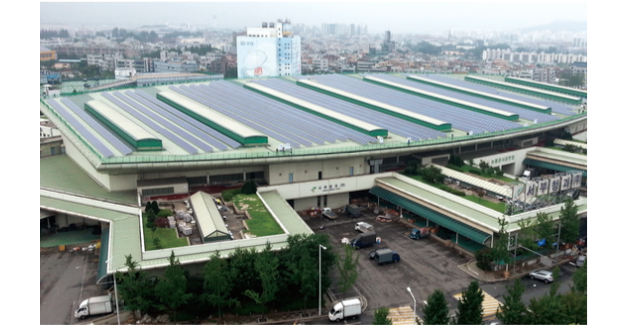
Source: One Less Nuclear Power Plant 2 Seoul Sustainable Energy Action Plan, Seoul City
- The operational stability of city-based facilities is maintained through an emergency power supply given by 174 MW fuel cell plants. These have attracted significant private investment and strengthened power independence by 2018, and have led to the installation of 20 MW-fuel cells in city based facilities, such as rail stations (Shinnae, Suseo, Jichuk) and the Seonam Water Regeneration Center.
- Group energy supply facilities are to be constructed to create stable heat supply to the Magok region. The expected heat demand will be met in connection with the Mokdong thermal convergence plant and GS Power’s Bucheon power plant. A 280 MW combined gas power plant is to begin construction in 2017 for use as a stable heat source after 2020.
- Policies on expansion of distributed power are also underway. To increase the installation of new renewable energy facilities over new large buildings with surface areas greater than 100,000 m², the SMG will give greater weighting to the mandatory installation of new renewable energy facilities in the EIA criteria.
Figure 10. Solar Panels Installed on a School Roof
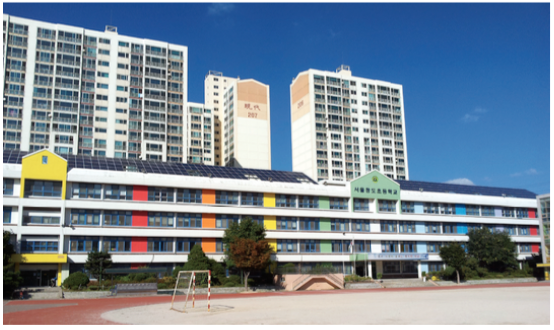
(Source: One Less Nuclear Power Plant 2 Seoul Sustainable Energy Action Plan, Seoul City)
3) The maximum use of energy in adjacent cities and wasted energy
- Wasted thermal energy is collected for regional floor heating. Energy will also be extracted from Jamsil Reservoir, water regeneration centers, and purification centers from water sources, and projects are planned to install a 3,160 kW hydro power plant by 2018.- Waste heat from adjacent local governments and private corporations is collected to supply heat for 10,000 units, and 35,000 Gcal are to be supplied per year in 2018 in connection with the metropolitan heating pipe networks.
- With participation from the public, the creation of energy resources is promoted by enhancing recycling of plastic and fabric. By 2018, bins for plastic will be used in all areas of Seoul to recycle 243,000 tons a year, and separate disposal of fabric will be enforced to recycle 168,000 tons a year.
Energy-efficient social structure
Figure 11. Goals in Creating an Energy-Efficient, Low Consumption Social Structure
| Efficient Use of Buildings | Changeover to LED | Environmentally-friendly Vehicles | Urban Planning |
| Energy diagnosis systematization (2015) Publication of energy efficiency (2015) |
Public sector 100% (2018), Private sector 25% > 65% (2018) | Increased charge for greenhouse gas emission | Production of an energy map, stronger inspection of environmental efficiency |
1) Introduction of improved energy efficiency and market principles for buildings through policy
- Policies are to be stricter in terms of energy audits of large buildings that consume 2,000 TOE of energy, and research to be done towards development of an energy reduction model for each application (hospitals, schools, professional facilities, and hotels)
- Financial support is to be increased, such as through loans for the efficient use of energy in buildings and housing; the size of these loans and the scope of covered facilities are to be increased, and an energy audit required upon applying for any BRP projects.
- Loans are to be expanded to include energy audits, eco-friendly boilers, and air conditioning devices, in addition to windows and insulation, as well as installation and replacement, operating systems, and monitoring costs. Furthermore, up to a 15% deduction from asset tax will be given for obtaining a new Green Architecture certificate or a new architecture energy efficiency level, and the same benefits are to apply to existing building efficiency projects.
- The verification system of the energy efficiency level evaluation report is to be enforced so that energy efficiency is reflected in real estate prices.
2) LED lighting in all public facilities
|
Figure 12. Solar panels installed at Yangcheon River 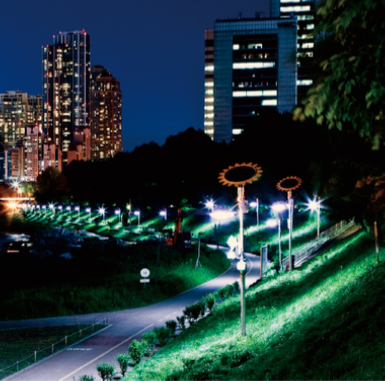 (Source: One Less Nuclear Power Plant 2 Seoul Sustainable Energy Action Plan, Seoul City) |
Figure 13. LED installation at Dongdaemun History and Culture Park
(Source: One Less Nuclear Power Plant 2 Seoul Sustainable Energy Action Plan, Seoul City) |
3) Human-oriented, energy-saving traffic environment city
- Electric vehicles are estimated to produce 25% less greenhouse gases when the energy generation phase is included, than fossil fuel vehicles. They also contribute to reducing the emission of fine dust.
4) Creation of an energy-efficient daily culture
- Recyclable waste will be converted to energy, while a variety of projects are initiated to connect this process to developing the industry and increasing employment. Recycling stations will be set up in the neighborhoods of detached single houses to increase the recycling rate and provide jobs. The 1,128 stations in 73 quarters that existed in 2014 will be expanded to 3,500 stations by 2016, and their efficient management will lead to increasing employment as an estimated total of 10,000 station personnel will be hired, with 15 to 30 personnel per station.
5) Reflecting energy concerns in city policy, including a climate energy map and urban planning
- The 2030 Urban Master Plan includes plans to create living zones towards minimizing the loss of energy during commutes and rush hours. The specifics include composition of pedestrian-friendly living zones adjacent to work and housing, transformation of spatial structures within metropolitan areas in connection with public transit to discourage the use of personal vehicles, and prevention of the expansion of energy-inefficient urban regions.
6) Reduction of GHGs through Phase 2 of the One Less Nuclear Power Plant initiative
- The SMG is preparing GHG inventories by apprehending their emission and identifying the current situation in each sector. It then uses these inventories as basic data for the GHG reduction plans and institutional direction. A GHG inventory organization is selected to establish and verify the plans. They will be implemented in line with the GHG emissions trading scheme.
Good energy worksites through innovation
Figure 14. Initial Goals of Good Energy Worksites through Innovation
| Structuralization of the green industry | Citizens’ energy project | Regional energy service | Support for green corporations |
| 6 green clusters | 70 social corporations and cooperatives | 25 energy hub centers | 234 enterprise-supporting corporations |
With continual investment in new renewable energy and LED, new facilities are to be installed, and service industries for post-management will be developed. This support will also extend to introduction of pioneering technologies suitable for Seoul, such as BEMS and the smart grid. Support that suits each stage of enterprise lifecycle will be strengthened after considering the many SMEs with undeveloped management skills and that the formation of an industrial market is in its initial stage.
Employment in the service industry is based on region, and thus, this project is to allow the participation of regional residents and in connection with the energy welfare of the community.
1) Green Metropolitan Seoul - Developing a green energy industry
Figure 15. Initial Direction of the Seoul Green Industry Cluster Development Project
| Pilot Operation | Expansion | Creation of Achievement |
| Creation of Pilot Cluster | Creation of Regional Clusters | Combination of Regional Clusters |
| * Demonstrative new renewable energy cluster project in G-Valley | * Beginning as a contest targeting areas where green industries are concentrated * Consortium of local governments, universities, research institutes and regional entities |
* Joint research and production of fused products that include solar power and LED * Nurturing of independent and global clusters |
- The SMG is initiating a smart grid (intellectual power network) pilot project towards establishment of a demand management market and to improve energy efficiency by fusing IT to the existing power network. A variety of projects are to be initiated according to the regional situation and characteristics of the city.
Specifically, a project will be initiated in Sadang-dong in connection with the community energy supply system (CES). The Urban Industrial Complex Efficient Energy Project is to be initiated in Guro Digital Industrial Complex, while a project to increase energy efficiency of the city’s subway system will be initiated by Seoul Metro, and an intellectual wiring power network is to be initiated in unit-divided apartments.
Together with these projects, electric gauges, which allow individual management of automatic power consumption and demand, will be supplied by half in 2016 and fully installed by 2020. Furthermore, an electricity usage information alarm system, which notifies users of electricity usage and gradual increases in real time, is to be developed and used in apartment buildings in Seodaemun-gu.
2) One-stop customized lifecycle support for green corporations
- To create jobs in the green industry, the development of green technologies (GT) has been actively supported. Financial support will be granted by 2018 for R&D in 7 major areas including vehicles, IT, new renewable energy, architecture, and LED lighting. GT research and development tasks that suit corporate demand are to be selected to support new technologies in connection with corporate-affiliated and university research institutes.
3) Creation of jobs in the green energy industry
- Seoul will establish as many as 25 regional energy hub centers by 2017, which will provide energy-related services to the public, such as installation of energy equipment, monitoring, and post-management, installation of LED lighting, installation of solar lighting, provision of price information, facilitation of group purchases, and product exhibitions. The centers will use the offices of resident groups, and lease space from public organizations when needed. There are also plans to expand into a service sales network and energy cooperatives.
Realization of welfare through sharing
Figure 16. Goals for Initiating Energy Sharing Communities
| Responsibility for energy welfare | Public participation | Conversion, increased efficiency | Community |
| Enacting Korea’s only energy welfare ordinance |
100,000 welfare fund participants | Low Income Insulation project to include 1100 units | 200 energy self-reliant neighborhoods |
A regional energy welfare policy suitable for local government is to be realized. To this end, institutional consideration is supplemented in regions that are not benefitting from central government welfare policies by reflecting each region’s characteristics. These include rented homes and lower class accommodation in the regions through enactment of an energy welfare ordinance and provision of basic energy rights.
Fundamentally, energy conversion projects are to be initiated that include increasing energy efficiency in homes and the reinforcement of solar light. Direct support of vouchers and energy costs are concurrently given in preparation for energy crises. Moreover, energy welfare officers will be trained to carry out specialized policies regarding energy welfare, and the energy functions in residential welfare support centers will be strengthened.
1) Guarantee of energy welfare rights through policy
- Seoul will raise an energy welfare fund for the public that is created, operated, and distributed by the people themselves. Funding is to include donations of profits earned from the production of energy and energy savings (including the use of solar power and LED lighting, increased insulation, and participation in the Eco Mileage program), and is to be used to provide assistance to the energy poor.
Figure 17. Public Participation in Policy
| Public participation | Resident management | Sustainable fund |
| > Participants in solar power, LED, and Eco Mileage projects | > Members of the 100 Citizens Committee (funding, management, delegation) | > Preparation of a legal basis for the fundraising, through the energy welfare ordinance > Connection with professional fund groups |
2) Building the foundation for regional energy communities
- A virtuous energy ecology is to be created in communities by expanding the citizen’s energy saving project. After analyzing the effect of two demonstrative power saving stations in 2014, ten more will be installed in 2015, and consecutively expanded from 2016. A citizen power saving station is initiated with the direction of promoting value by reinvesting and sharing the incentive given to eco mileage members. A main fundamental group of the region will be selected, and a director trained for each power saving station will serve as a coordinator. An ”Energy Station” for energy recharging services will be run in each neighborhood, and investment for energy projects will come by reforming the Eco Mileage system and an energy saving point system.
Figure 18. Energy Projects through the Public Participation System
| Eco Mileage reduction point system | Power saving stations in each neighborhood | Energy project investment and consumption | Neighborhood corporations |
| > Citizen power saving station | > Coordinator groups, power saving station director > Networking, promotion, etc. |
> Energy station > Energy supermarket, BRP, solar light, etc. |
Citizen fund |
Policy Effect
1) Proposal of vision and successful model of regional energy policy
The One Less Nuclear Power Plant initiative is an energy policy that expands the former focus on energy saving to the generation of new renewable energy and BRP, which has reduced the total consumption of energy such as electricity, gas, and fuel. Furthermore, regardless of the restriction of a local government group, it is evaluated that a successful model of a regional energy policy is proposed through creative policy improvements and projects. Seoul’s good policies, such as feed-in tariffs (FIT), improved rental of solar power generation sites, and the supply of mini solar power in particular, have been expanded to other district groups.
2) Improvement of public awareness of energy policies and revitalized public participation
The One Less Nuclear Power Plant initiative can be considered a citizen-led energy policy. As many as 1.68 million Seoul citizens have participated in the Eco Mileage program, and around 20,000 students in the Energy Guardian Angel group to partake in energy saving at home and school.
This public participation is estimated to be based on the active support people have given the One Less Nuclear Power Plant initiative. According to a survey conducted on this initiative in March 2014, as many as 71% of the respondents said they knew about it. Furthermore, since 59% of the respondents stated that the initiative was ‘good’, it appears to be something that is highly regarded and necessary in Seoul at the current stage.
3) Formation of initial basis for energy-related industry and employment
The One Less Nuclear Power Plant initiative has revitalized the Korean LED market through the supply of LEDs to large public facilities, including the replacement of all lighting in subway stations and the installation of LEDs in new public offices, and has attracted KRW 600 billion in private capital to contribute to the preparation of employment in production and installation of new renewable energy sources, such as solar power and fuel cells. Furthermore, energy planners have obtained new employment in the establishment of three cooperatives based on energy diagnosis in commercial buildings.
Policy outcome
Outcome of Phase 2 of the One Less Nuclear Power Plant Initiative
1) Initiation of the core index of Phase 2, including increasing energy self-reliance
Figure 19. Achievements in Energy Self-Reliance
| Index | Goal (Jul 2014 – Dec 2015) | Outcome (Jul 2014 – Sep 2015) |
| Energy self-reliance rate | 7.0% (2014 Goal: 5.0%) |
4.7% (based on facility capacity at the end of 2014) |
| Increased efficiency in generating energy and reducing consumption | 902,000 TOE | 910,000 TOE |
Figure 20. Reduction and generation of energy in main projects (Unit: 1,000 TOE)
| Generation (64,000 TOE) | Increased efficiency (495,000 TOE) | Saved (351,000 TOE) |
| * Solar power 8.3 * Fuel cells, etc.: 55.6 |
* Green architecture planning: 225 * Energy efficiency of buildings: 86.4 * Use of LEDs: 176.2 * Traffic: 7.3 |
* Eco Mileage program: 351 |
2) Main achievements
In order to expand the supply of mini solar power plants, which was actively pursued from Phase 2, the support that was provided only to housing units installing the mini plants was then expanded to all areas (including the public sector) by increased contact with citizens and sales at large supermarkets and other locations. Furthermore, a pilot project installed enough solar panels on sale booths to generate 2,528 kW in 3,469 areas by September 2015.
Seoul has established a special-purpose company (SPC) to be exclusively in charge of replacing lighting with low-energy, high-efficiency LED units and has used private capital to replace 93,000 lighting fixtures in 48 business sites in Seoul and 13 other district areas as part of the public lighting replacement project. The project to replace approximately 210,000 lighting fixtures in subway station offices and control rooms (Seoul Metro, Urban Railway Cooperation) was enforced by this SPC and to be completed in October 2015. With the addition of 430,000 lighting fixtures in Phase 1, a total of 640,000 fixtures, excluding interior subway train lighting, were exchanged.
A fund worth KRW 1.6 million in cash and gifts (LEDs, etc.) was raised and in January 2015, the Seoul Social Welfare Association was selected to administer the fund, and an agreement was then concluded. In July 2015, the Seoul Citizens’ Energy Welfare Fund Council was established, and a volunteer university group created. Since a warm social atmosphere is important for the success of energy welfare, in addition to physical support, an energy welfare fund website was constructed to invite people to create a cordial living environment. Funding has also been raised by the public through donations and promotion.
Figure 21. Annual Goals for the Energy Welfare Fund
| 2015 | 2016 | 2017 | 2020 |
| KRW 200 million | KRW 600 million | KRW 1.7 billion | KRW 3 billion |
Main challenges and solutions
After 2015 and the official beginning of Phase 2 of the One Less Nuclear Power Plant initiative, there were some obstacles caused by changes in external conditions and deterioration of the social environment, including the outbreak in Korea of Middle East Respiratory Syndrome (MERS). Accordingly, there was a need to modify the strategies and goals of the project. There was also a need to adjust the excessively high goals of certain projects that had to be done in cooperation with other organizations.
The Home Energy Clinic Service project involved energy planners visiting homes or businesses to check energy usage patterns and provide information on how to save energy. However, it was difficult to continue in the first half of 2015 due to the spread of MERS and people’s fear of meeting others due to the potential contagion. In the Wooden Pallet Usage Boiler project, it was difficult to secure the necessary space, which resulted in a reduction of demand and necessitated modification of the project target to public facilities.
Although these setbacks were eventually overcome and the goal reached, new strategies will likely be needed to achieve the Phase 2 goals of the One Less Nuclear Power Plant initiative.
Accordingly, the cooperative system between the One Less Nuclear Power Plant Executive Committee and related organizations has been reinforced and the opinions of experts in the Seoul International Energy Advisory Group will be collected to devise an efficient system of strategies towards achieving the core goals by 2020.
Of the core projects in the One Less Nuclear Power Plant initiative, the solar power project is the only one to focus strictly on power generation. However, as it was initiated to attract private investment, public attention is essential. For instance, instead of installing solar panels only on school roofs, installation on streetlamps near schools will allow people to personally experience and benefit from the results.
Although fuel cells, one of the major renewable energy sources, are used in large buildings or for power generation, the policy has not been properly pushed. Fuel cells create electricity using hydrogen or natural gas, and are not, in themselves, a form of pure renewable energy. They have limitations as they consume more gas to generate energy. There is a need to consider a subsidiary support system for the fuel cell as for the solar panel project. Overcoming these problems is expected to contribute to the reduction of greenhouse gases and the generation of new renewable energy in Seoul. If the city can overcome these and other challenges, great advances will be made towards reducing GHG emissions and developing new renewable energy.
.PNG)
.PNG)
.PNG)
.PNG)
.PNG)
.PNG)
